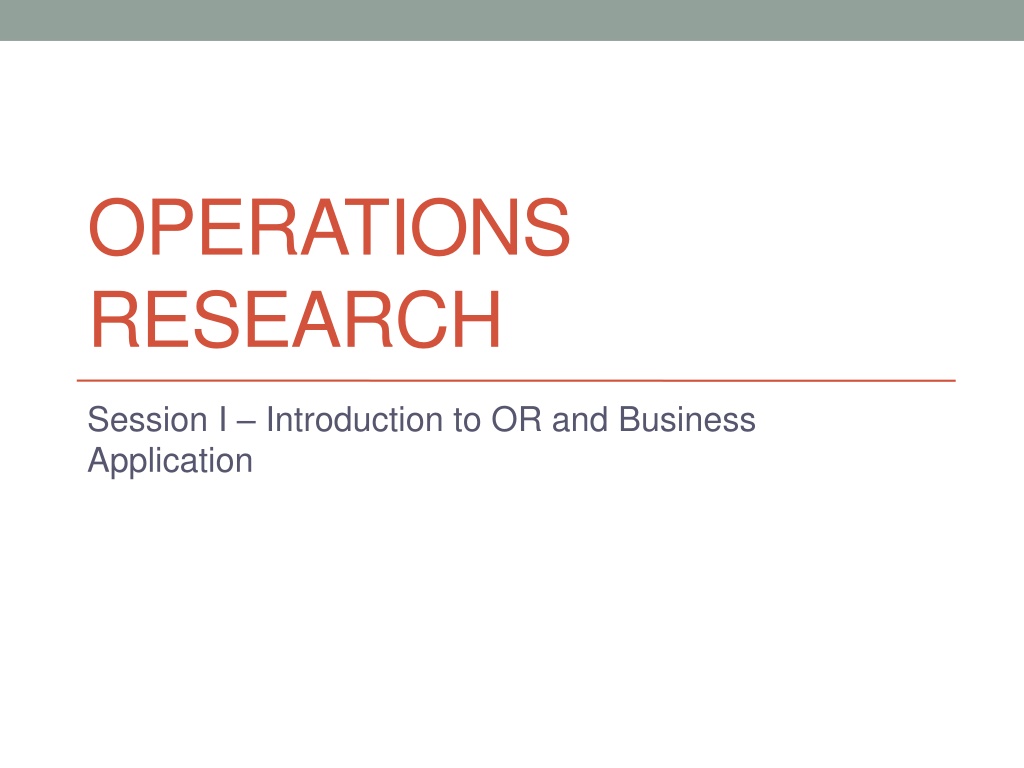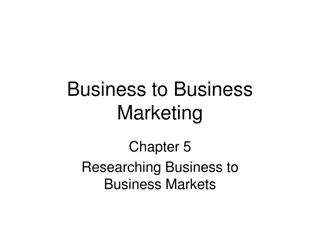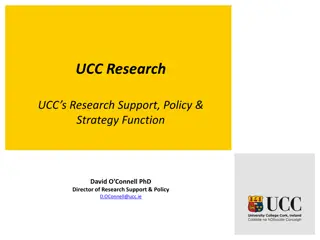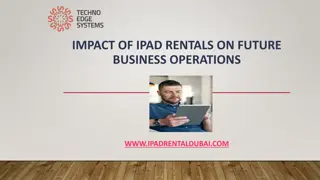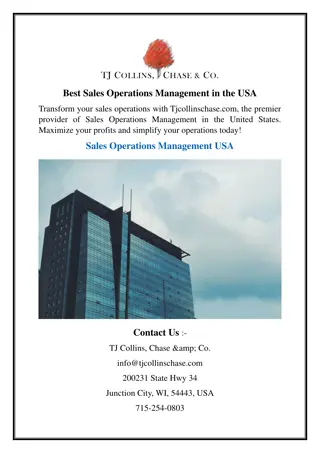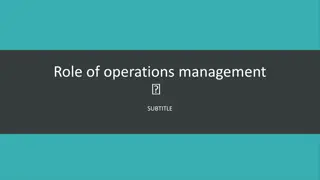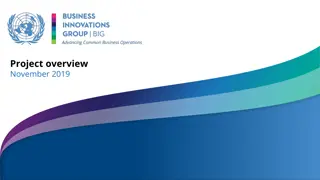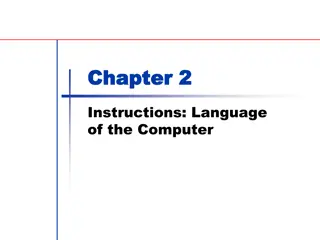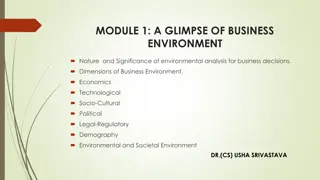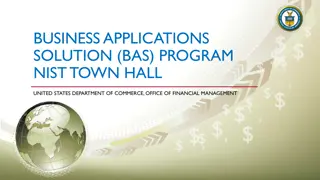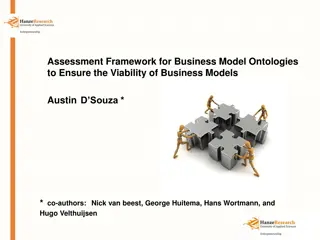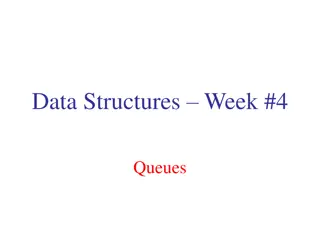Introduction to Operations Research in Business Applications
Operations Research (OR) is a scientific approach to decision-making that focuses on finding the best solutions under various constraints and objectives. Originating from World War II military operations, OR models help optimize resources in industries like defense, agriculture, and healthcare. This field involves identifying decision alternatives, determining objective criteria, and designing models to provide quantitative support for effective decision-making.
Download Presentation

Please find below an Image/Link to download the presentation.
The content on the website is provided AS IS for your information and personal use only. It may not be sold, licensed, or shared on other websites without obtaining consent from the author.If you encounter any issues during the download, it is possible that the publisher has removed the file from their server.
You are allowed to download the files provided on this website for personal or commercial use, subject to the condition that they are used lawfully. All files are the property of their respective owners.
The content on the website is provided AS IS for your information and personal use only. It may not be sold, licensed, or shared on other websites without obtaining consent from the author.
E N D
Presentation Transcript
OPERATIONS RESEARCH Session I Introduction to OR and Business Application
Operations Research Operations Research revolves around : What are the decision alternatives ? Under what restrictions is the decision taken What is an appropriate objective criterion for evaluating the alternatives OR models are designed to optimize a specific objective criterion subject to a set of constraints, the quality of the resulting solution depends on the completeness of the model in representing the systems
Operations Research Origin Operations Research (OR) started just before World War II in Britain with the establishment of teams of scientists to study the strategic and tactical problems involved in military operations. The objective was to find the most effective utilization of limited military resources by the use of quantitative techniques.
OR Defined a scientific approach to decision making, which seeks to determine how best to design and operate a system, usually under conditions requiring the allocation of scarce resources. Winston a scientific method of providing executive departments with a quantitative basis for decisions regarding the operations under their control. Kimball and Morse
OR Industry Scope Defense Operation - Linear Programming, Game theory, and inventory models etc. Industry - decision trees, inventory model, Linear Programming model, Transportation model, Sequencing model, Assignment model and replacement models Planning for Economy - All major models Agriculture - All major models Traffic - queuing theory Hospitals queuing theory
Common models in OR Linear Programming Model - used for resource allocation when the resources are limited and there are number of competing candidates for the use of resources. (a) A company which is manufacturing variety of products by using available resources, want to use resources optimally and manufacture different quantities of each type of product, which yield different returns, so as to maximize the returns. (b) A company manufactures different types of alloys by purchasing the three basic materials and it want to maintain a definite percentage of basic materials in each alloy. The basic materials are to be purchased from the sellers and mix them to produce the desired alloy. This is to be done at minimum cost. Both of them are resource allocation models, the case (a) is maximization problem and the case (b) is minimization problem.
Common Models in OR (c) Number of factories are manufacturing the same commodities in different capacities and the commodity is sent to various markets for meeting the demands of the consumers, when the cost of transportation is known, the linear programming helps us to formulate a program to distribute the commodity from factories to markets at minimum cost. The model used is transportation model. (d) When a company has number of orders on its schedule, which are to be processed on same machines and the processing time, is known, then we have to allocate the jobs or orders to the machines, so as to complete all the jobs in minimum time. This we can solve by using Assignment model.
Common Models in OR Sequencing Model When a manufacturing firm has some job orders, which can be processed on two or three machines and the processing times of each job on each machine is known, then the problem of processing in a sequence to minimize the cost or time is known as Sequencing model.
Common Models in OR Waiting Line Model or Queuing Model A model used for solving a problem where certain service facilities have to provide service to its customers, so as to avoid lengthy waiting line or queue, so that customers will get satisfaction from effective service and idle time of service facilities are minimized is waiting line model or queuing model Program Evaluation and Review Technique (PERT) and Critical Path Method (CPM) are two techniques that are widely used in planning and scheduling the large projects
Common Models in OR Replacement Model Any capital item, which is continuously used for providing service or for producing the product is subjected to wear and tear due to usage, and its efficiency goes on reducing. This reduction in efficiency can be predicted by the increasing number of breakdowns or reduced productivity. The worn out parts or components are to be replaced to bring the machine back to work. This action is known as maintenance. A time is reached when the maintenance cost becomes very high and the manager feels to replace the old machine by new one. This type of problems known as replacement problems and can be solved by replacement models. Inventory Models Any manufacturing firm has to maintain stock of materials for its use. This stock of materials, which are maintained in stores, is known as inventory. Inventory is one form of capital or money. The company has to maintain inventory at optimal cost. There are different types of inventory problems, depending the availability and demand pattern of the materials. These can be solved by the application of inventory models.
Burger King uses linear programming to determine how different cuts of meat should be blended together to pro- duce hamburger patties at minimum cost while still meet- ing certain specifications such as fat content, texture, freshness, and shrinkage. As the cost of different cuts of meat changes, the firm reevaluates its model to determine whether its recipe should be modified.
American Airlines Scheduling aircraft crews is a complex problem involving such factors as the type of aircraft to be flown, the cities of origination and termination for the flight, the intermediary cities visited by the aircraft, and the length of the flight. Federal and union rules govern the placement of personnel on the aircraft. To address these issues, American Airlines has developed an integer linear programming model that allows the company to quickly determine an optimal flight schedule for its personnel.
Sony Advanced Traveler Information System The marriage of the microprocessor with the Global Positioning Satellite System has enabled Sony Cor- poration to develop an onboard navigation system capable of giving directions to a car s driver. This information is especially valuable during traffic conditions such as rush hour congestion. The software is based on an operations research model known as a shortest path network.
The Interstate 10 Freeway Following the California earthquake in January 1994, Interstate 10, a main freeway serving the Los Angeles area, needed to be rebuilt quickly. The project prime contractor was given a fairly short 5 month deadline to reopen the roadway. To encourage the work to be done as quickly as possible, the contractor was offered a bonus of $500,000.00 for each day by which it was able to beat the deadline. Using a project scheduling technique known as the critical path method , the contractor was able to schedule work crews so as to be able to complete the repair work a month earlier than the project deadline. As a result, the contractor collected a $15 million dollar bonus.
Cooking at Mrs. Fields Mrs. Fields operates a nationwide chain of cookie shops specializing in fresh-baked chocolate chip cookies. The chain has equipped each shop with a PC-based information system to aid personnel in deciding when additional cookies should be baked and the amounts that should be produced. This system relies on the operations research techniques of demand forecasting and inventory modeling .
Disneyland & Disneyworld Lines form as visitors await their turn to ride or view the most popular attractions. Disney incorporates waiting line or queuing models into its overall design plans for the park. These models mirror customer behavior and tolerance for waiting in line. As a result, Disney developed an entirely new industry of waiting line entertainment to maintain customer satisfaction levels and enhance the value and excitement of the ride or attraction.
New York City Trash NYC handles over 20,000 tons of garbage per day. To dispose of this trash, the city operates 3 incinerators. Refuse is also sent by barge from marine transfer sta- tions to the Fresh Kills Landfill. To determine future operational plans for this landfill, the Department of Sanitation undertook an operations research analysis. The result was development of the BOSS ( barge operation systems simulation ) model. This simulation model enabled the department to determine the number of additional barges that should be purchased to handle future demands. It also helped plan the dispatching of these barges.
Quality Management at Ford During the 1970s, U.S. automobile manufacturers saw a steady decline in their market share due to competition from Japanese and European manufacturers. In response, Ford Motor Co. embarked on a Quality Is Job One campaign. Suppliers were held to tighter standards, and new quality control procedures were developed. As a result of these quality management activities, the firm was able to reverse its decline in market share and profitability.
